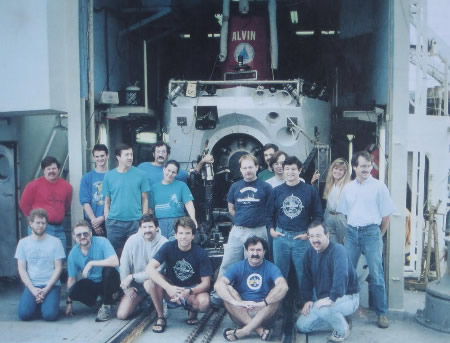About our Research-
Highlight:
30 Year History of Vents Program Published in Oceanography

A 30-year history of the NOAA Vents program was published in Oceanography. In 1983, a small team of NOAA PMEL scientists, subsequently joined by colleagues at Oregon State University (CIMRS) and the University of Washington (JISAO), exploited new seafloor and water column mapping technologies to understand the impact of hydrothermal systems on ocean chemistry and seafloor ecosystems. The first decade featured fundamental discoveries about physical, biological, chemical, and oceanographic consequences of deep submarine eruptions. Partnering with international researchers, Vents made the first ever time-series studies of active submarine eruptions. Vents research set global standards for an observation-driven understanding of the transfer of heat, chemicals, and organisms from Earth’s hot interior into the ocean.
In 2013, the Vents Program was restructured into two new programs, Earth-Ocean Interactions and Acoustics, continuing the Vents legacy while focusing directly on NOAA strategic goals in ocean processes and ecosystems.
The complete article can be viewed at the Oceanography website:
http://tos.org/oceanography/assets/docs/28-1_hammond.pdf
(Bibliography of EOI/Vents Program can be found here).
The following is a brief history of the VENTS Program and its successor the Earth Ocean Interactions Program:
 |
| Photo from a Vents expedition to the Juan de Fuca Ridge with the manned submersible Alvin in 1991. Front row (L-R): Mike Stapp, Bob Embley, Bill Chadwick, Dan Dion, Ian Johnasson, Gary Massoth. Back row (L-R): Richard Feely, Chris Meinig, Randy Koski, John Lupton, Sharon Walker, John Trefry, Kevin Roe, Jim Gendron, Ed Baker, Andra Bobbitt, Dave Butterfield. |
The VENTS Program was established in 1983 with the goal of quantifying the impact of mid-ocean ridge hydrothermal venting on the oceans. Early successes included unexpected discoveries of boiling hydrothermal fluids in the deep sea and the instantaneous release of massive hydrothermal discharges dubbed “megaplumes” or “event plumes.” These observations showed, for the first time, that seafloor eruptions catalyze the exchange of large quantities of heat and chemicals between the Earth’s crust and the overlying ocean, and led to the discovery that these releases also include heat-loving microorganisms that live in the “subsurface biosphere” below the seafloor. These realizations spurred VENTS to develop new technologies for studying such events, including the remote detection of seafloor eruptions.
In 1991, VENTS became the only non-classified, civilian research program with continuous, real-time access to the U.S. Navy's arrays of seafloor hydrophones. Using this new data, VENTS created the first detection and location system sensitive enough to reveal the occurrence of seafloor eruptions in the northeast Pacific. Only two years later, this system recorded the first real-time acoustic signature of a deep-sea eruption as it was happening. VENTS and collaborative researchers in the NSF RIDGE program immediately pioneered the concept of fast-response expeditions, with ship-borne scientists arriving at the eruption site only days to weeks after the eruption began. The exciting scientific results made possible from real-time monitoring and detection of multiple seismic and magmatic events was a primary driver in choosing this region for a multi-million dollar NSF cabled seafloor observatory.
By this time, the VENTS Program recognized that the true diversity of hydrothermal ecosystems and resources could not be cataloged without a global approach to observation and sampling. The combined expertise of VENTS scientists along with new technologies have been used to discover unknown hydrothermal systems worldwide and gain an understanding of their global impact on ocean ecosystems. As a result of VENTS exploration, discovery, and research, many unique and previously unknown habitats have been exposed, new species of benthic animals have been described, and our understanding of the incredible microbial biodiversity of the global sub-seafloor biosphere and its impact on ocean chemistry and ecology has continued to grow.
Beginning in 2001, VENTS partnered with NOAA’s Ocean Exploration and Research Program to start a systematic study of volcanic arcs behind western Pacific subduction zones, a region that now includes the Mariana Trench Marine National Monument. In this virtually unexplored realm they discovered and characterized new ecosystems and new species, captured the first direct observations of deep-sea eruptions, discovered voluminous venting of both gaseous and liquid carbon dioxide, and sampled craters filled with pools of molten sulfur. The discovery of these high-acidity, animal-rich habitats provides a broad array of natural laboratories to study the effects of ocean acidification on endemic populations and the adaptations of marine ecosystems to such conditions.
In 2013, The NOAA/PMEL VENTS Program was re-organized into two separate focused programs: Earth-Ocean Interactions and Acoustics .The Earth-Ocean Interactions Program continues this history of exploration, discovery, and research by combining a wide range of scientific expertise and advanced technologies in an interdisciplinary approach to hydrothermal ecosystem studies. Ocean water column physical and chemical measurements illuminate the sources and distribution of life-limiting ocean nutrients and are combined with multi-scale seafloor mapping to discover novel and critical benthic habitats. Coordinated chemical/microbiological sampling techniques are used to quantify microbial diversity and the role of microbes in mediating chemical reactions. Benthic biological communities are analyzed and related to their chemical environment and their biogeographical context, while local-to-regional-scale ocean circulation models predict the effects of seafloor topography on the distribution of tracers and the dispersal of larvae. Innovative ocean engineering expertise is directed at developing new deep-sea observing and sampling technologies. The synergy of these multiple disciplines produces new approaches to accomplishing existing NOAA priorities.
